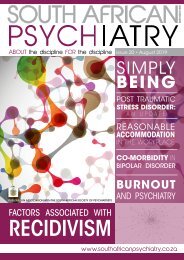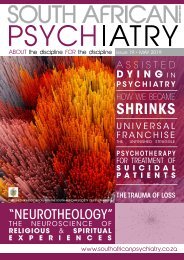South African Psychiatry - February 2019
South African Psychiatry - February 2019
South African Psychiatry - February 2019
Create successful ePaper yourself
Turn your PDF publications into a flip-book with our unique Google optimized e-Paper software.
REPORT<br />
CELLULAR<br />
NEUROSCIENCE<br />
OF PSYCHIATRIC<br />
DISORDERS<br />
Tanya Calvey<br />
On the 23 rd of November, 2018, the Wits<br />
Cortex Club hosted two prominent<br />
neuroscientists (Profs. Harry Steinbusch<br />
and Marie-Ève Tremblay) to address<br />
the Wits Faculty of Health Sciences on cellular<br />
mechanisms involved in various psychiatric<br />
disorders. The lunch time seminar took place in<br />
the Adler Museum of Medicine and was funded<br />
by the National Research Foundation and the Wits<br />
Department of <strong>Psychiatry</strong>.<br />
Marie-Ève Tremblay is an Associate Professor of<br />
Molecular Medicine at Université Laval, Québec,<br />
Canada. Her research focuses on elucidating the<br />
roles of microglia in the loss of synapses, which<br />
is one of the best pathological correlates of<br />
cognitive decline across chronic stress, aging, and<br />
neurodegenerative diseases.<br />
Her seminar ‘Dark microglia across contexts of health<br />
and disease’ uncovered the recent characterization<br />
by her laboratory of an ultra-structurally distinct<br />
microglial subtype that is predominantly associated<br />
with pathological states. These cells are rare in<br />
steady state conditions, but become prevalent<br />
upon chronic stress, aging, and Alzheimer’s disease<br />
pathology, where they account for two-thirds of the<br />
normal microglial population. They exhibit several<br />
signs of cellular stress including a condensed,<br />
electron-dense cytoplasm and nucleoplasm giving<br />
them a ‘dark’ appearance in electron microscopy,<br />
accompanied by endoplasmic reticulum dilation,<br />
mitochondrial alterations, and a loss of nuclear<br />
heterochromatin pattern. The physiological<br />
significance of these dark<br />
microglia has yet to be elucidated<br />
but they appear extremely active,<br />
frequently reaching for synaptic<br />
clefts, while extensively encircling<br />
axon terminals, dendritic spines,<br />
and excitatory synapses with their<br />
highly ramified and extremely thin<br />
processes. In addition, her recent<br />
work revealed the occurrence<br />
Tanya Calvey<br />
of these dark microglia in a<br />
schizophrenia mouse model induced by a prenatal<br />
immunological challenge, as well as in early<br />
postnatal brain development, two conditions where<br />
synaptic pruning is exacerbated.<br />
THESE FINDINGS INDICATE THAT DARK<br />
MICROGLIA COULD REPRESENT A SUBSET<br />
OF CELLS THAT BECOME STRESSED<br />
AS A RESULT OF THEIR HYPERACTIVE<br />
INVOLVEMENT WITH THE REMODELING<br />
OF NEURONAL CIRCUITS ACROSS<br />
DEVELOPMENT, PLASTICITY, AND DISEASE.<br />
Prof. Harry Steinbusch is appointed as Professor in<br />
Cellular Neuroscience, chairman of the Department<br />
of Translational Neuroscience, past-director of the<br />
School for Mental Health and Neuroscience, current<br />
Director of the European Graduate School for<br />
Neuroscience at Maastricht University and President<br />
of the Neurotoxicity Society. He is the founding editor of<br />
the Journal of Chemical Neuroanatomy. His research<br />
SOUTH AFRICAN PSYCHIATRY ISSUE 18 <strong>2019</strong> * 53
















